
|   |

|   |
7th edition of Mukteswar Dance Festival at Bhubaneswar (Jan 14 - 16, 2012) - Dr. Sunil Kothari e-mail: sunilkothari1933@gmail.com Photos courtesy: Odisha Tourism & Arabinda Mahapatra January 20, 2012 The Mukteswar temple (10th Century AD) is a gem of a temple amongst innumerable temples in Bhubaneswar. Its architecture is arresting and graceful. The 'toran' - the arch - before the entrance is breathtaking. And lighting by that lights wizard Jaydev transforms it into a world where gods and goddesses and their devotees walk again. Sculptures leap to life when dancers enter from behind, framed against the exquisite backdrop. The music fills the air, the drum beats make you sit up in your chair and before our very eyes the dancers transport us to a world peopled by celestial beings. By a happy coincidence way back in 1984, that devotee of Lord Jagannath, a scholar, poet, commentator, musician, constantly under the spell of Gita Govinda, Subas Pani, during his tenure in Govt. of Orissa, organized Mukteswar Dance Festival featuring Sanjukta Panigrahi, Kum Kum Mohanty, Usha Bilas dance drama choreographed by Pankaj Charan Das, and Gita Govinda by Kelucharan Mohapatra, on the occasion of Golden Jubilee of Orissa State Museum. One was wonderstruck by Subas Pani's imagination and initiative to mount a unique dance festival in such amazing ambience. As the Head and Professor of Dance Department of Rabindra Bharati University at Kolkata, I was invited to attend the festival. I wrote about it in The Statesman and The Economic Times welcoming this initiative, least knowing that after almost 21 years once again it will continue drawing crowds to witness solos, duets and group performances of Odissi dancers. But the dream has come true. Covering dance festivals nationally and internationally, I have come across and have worked in close contact with several bureaucrats. But I must admit I have not come across someone like Mr. Ashok Kumar Tripathy, IAS, Principal Secretary to Govt, Tourism and Culture Department of Odisha and Managing Director of Odisha Tourism Development Corporation Ltd. His passion for culture, dance, music and other artistic expressions is so transparent that one cannot but help admiring him. He is all the time on his feet, paying attention to smallest details. The illumination he has started at the venues is mesmerizing. Rabindra Mandap at night is all aglow with tiny colourful bulbs. The auditorium and those venues, improvised ones, acquire a new identity with a mood of festivity. Entire Bhubaneswar seems to be celebrating festivals. December 2011 and January 2012 will go down in history of dance in Odisha for innumerable events including Guinness Book world record and international Odissi dance festivals - 2nd edition of Odissi International Festival started by Shyamhari Chakra, Ramhari Das and Kedar Mishra and the 4th edition of International Odissi Festival organized by Pratap Das and his Washington based organization Indian Performing Arts Promotion (IPAP). There was Gotipua Dance Festival, followed by in succession, Konark Dance Festival, Dhauli and Martial Arts Festivals, Odissi international dance festivals ending on 30th December and by the time you say Happy New Year, we are witnessing Mukteswar Dance Festival followed by Raja Rani Temple Classical Music Festival from 18th to 20th January 2012! This is not all. Hold your breath - Mr. Tripathy has initiated Sand Festival at the beach near Konark temple and of course he had organized handicraft exhibitions and what have you! Festivals galore! That one man with boundless energy can make such a vast difference indeed is laudable. 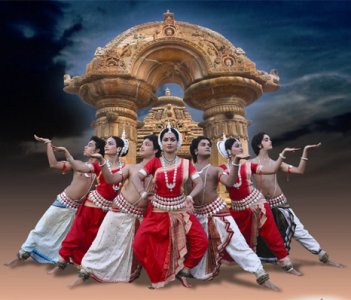
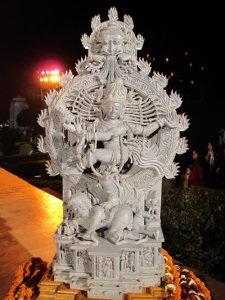 Sculpture by national awardee Sudhakar Sahoo that was placed on stage Mukteswar temple has Kedar Gauri temple and many shrines. The stage is so well positioned that you see three temples on either side of the main temple with the arch. The entire complex was so well designed and decorated with flowers; chairs were provided and two large screens helped audiences watch performances on the screens. Regularity is a virtue. Two comperes, Mrityunjay for Oriya and Sanhati Pani, that beauteous daughter of Subas Pani for English, DD directly telecasting nationally performances from 6pm till 8.30pm, audiences watching in disciplined manner - the infrastructure and a dedicated team of workers under Mr. Tripathy's leadership make you wonder if such events are possible, offering us sheer pleasure. Every evening started with prayers rendered in group by leading musicians including legendary Raghunath Panigrahi, and then followed solo, duet and group dances. No dancer encroached upon next artiste's time. A well designed, attractive program book, illustrated with photographs of participating dancers, giving credits for the musicians, rhythm, script, brief synopsis, introductions of dancers, raga and tala has made it a collector's item. Such meticulous care places this festival in a class by itself. If I have written all this in such detail, I have done it on purpose so other festival organizers can follow suit. After Shiva Vandana by students of Utkal Sangeet Mahavidyalaya, Kolkata based celebrated Odissi exponent Aloka Kanungo, a disciple of Guru Kelucharan Mohapatra, presented solo numbers. A versatile dancer, Aloka has the beauty of a miniature painting. Her mobile visage registers expressions vividly. The anga sanchalana - bodily movements - are perfect, complete and a delight to watch. Her Kamodi pallavi composed by Ramhari Das highlighted her command over movements in nritta. She was not dwarfed by the temple and shone forth with grace and beauty. Loknath's composition of Vatsalya bhava, Yashoda's love for Krishna, came alive in Aloka's rendering. Making Krishna dance with words "Nachibo ta thia ta thai," one had a glimpse of little Krishna's endearing beauty. 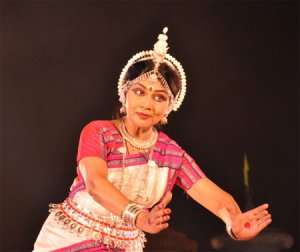 Aloka Kanungo 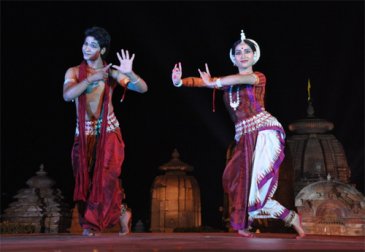 Pravat Kumar Swain and Arupa Gayatri Panda Duet by Pravat Kumar Swain and Arupa Gayatri Panda had commendable coordination in Khamaj pallavi choreographed by Aruna Mohanty, though I would suggest them to control their expansive movements. In two episodes of Arjuna, one as Brihannala teaching dance and the other not wanting to fight during Kurukshetra war, Pravat essayed his two different roles competently. However, even when the war demands charging and shooting a shower of arrows, the energy level needs control. Pravat has a Gotipua background and has developed into one of the finest male dancers. It is youthful energy which needs to be channelized. Aruna Mohanty and Madhusmita Mohanty deserve compliment for training them so well. What stole my heart was our Italian connection Ileana Citaristi's dance-drama Maana Bhanjan. Based on the original script by Babaji Baishnaba Charan Das and Mohan Sundar Deva Goswain, featuring offended Radha, seductive Chandrabali and repentant Krishna, who under different disguises attempts to win back Radha, has a charm of its own. Kelucharan Mohapatra had used similar sanchari bhavas in Gita Govinda ashtapadi "Yahi Madhava, Yahi Keshava" inspired from Maana Bhanjan. The black of Krishna's lips that Radha notices is not because of kissing eyes of other gopi, but the juice of jamun fruit he tested before bringing them for her, nor are they nail marks on his body, but are of thorns when he tried to collect flowers for Radha. In full fledged rasalila as must have been performed in the past, there must be great charm and traditional songs in traditional tunes must have been heavenly, but not being fortunate enough to have even seen it, a little glimpse of it was enough for me to relish it. And I asked Kedar Mishra and Aruna Mohanty to give me CD of the same for further enlightenment. 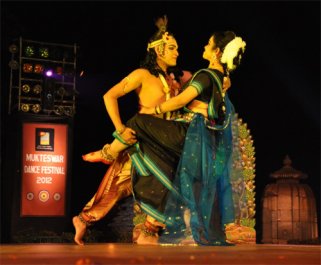
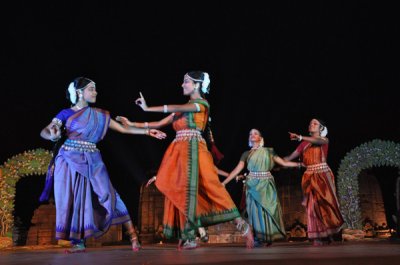
I have seen parallel themes in Manipuri in choreography of Guru Bipin Singh's Bajigar vesha when Krishna comes in disguise to please Radha, performs acrobatic feats and so on. In Maana Bhanjan, Krishna impersonates a gopi and comes to paint Radha's feet and naughtily writes name of Krishna on the sole of her foot! He comes as jogi - a mendicant - asking to have a glimpse of Radha's visage, Krishna's lies, and in final scene, all sing "Jhulavo Kishori kana Kunje" when Krishna and Radha reconcile, celebrating their reconciliation when the couple sits on the swing. These are shared traditional songs and all know them and also sing along when watching the dance. Ileana used two kunj bowers also as a backdrop. Traditionally these are independent bowers of Krishna and Radha. Ileana's version relied more on 'Deshi' than 'Margi' communicating shared tradition of songs rather than following rasalila version. Ileana loves Oriya language and relishes it. Even when there was less of dance, the sheer magic of songs and unalloyed abhinaya were able to carry the presentation, for someone like me, successfully. Saswat has stage presence and carries himself well as a handsome Krishna. Gopis and Ileana went through their steps in unobtrusive manner. Music, since I do not have terms of reference, looked alright to me. And of course the lyrics were superb with their own charm. I would like other Odissi exponents to bring these gems to other metropolitan centres, for Oriya literature and poems have a distinct charm of its own. Also, Odissi music has its own flavor. It would be a bonanza. On the 2nd day, solo performer Rahul Acharya, disciple of Guru Durga Charan Ranbir, performed Krishna Mangalacharan with elan, embellishing it with Sabdaswarapata energetically, bringing out fine texture. Pallavi in Chakravak raga had exquisite vaksha chalan, torso movements, firm chauka, square position, eka pada bhramari, revolution on one foot, also reverse viparita bhramari, displaying strong foundation. Placing arm on waist and having exquisite neck movement, he often framed his face with raised arms in mushti and suchi hasta. Bhagirathi's song "Mina Nayana" dwelling upon the vipralambha shringara, lover in separation, unable to bear the thunder of clouds, "Ghana Ghana suni" et al was enjoyable. He is a rising star from young generation, winning Sangeet Natak Akademi's Bismillah Khan Yuva Puraskar, and winning laurels for performances within India and abroad. I have seen his performances in America and am favourably impressed. He has sound understanding of text, be it in Oriya or Sanskrit and that is an asset which he knows shall stand by him in his expressional numbers. 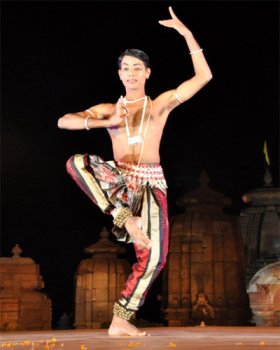 Rahul Acharya 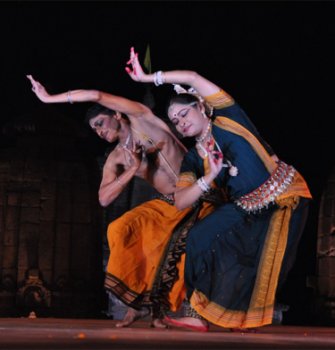 Chittaranjan Acharya and Asmita Kar Mohapatra Chittaranjan Acharya, a disciple of Pankaj Charan Das, performed pallavi in Sahana with his daughter Asmita to music composed by Krishna Chandra Ray followed by Panchastavaka which deals with five nayikas, composed by Mangal Prasad. Not having seen it earlier and watching it I could only follow the lyrics which extolled Radha, "Jaya Raseswari Radha" but I did not comprehend it as pancha nayika depiction. Both performed to the best of their ability. Nazia Alam sang with feeling. The group choreography by Bichitranand Swain of Rudrakshya group consisting of mainly male dancers drew attention for their uniform training and energy. The stuti in praise of Surya, 'Pranatosmi Divakaram' had fine passages of choreography - the image of Sun god driving a chariot drawn by seven horses that left an indelible impression. The blowing of conch was a good musical touch. Ananda Bhairavi pallavi with two female dancers and male dancers had also imaginative choreographic touches. In the finale 'Narayani namostute,' the depiction of Shakti through the male dancers was just brilliant. The absence of female dancer did not detract from its presentation. It was so charged that gender divide did not draw any attention. Among the male dancers, Lingaraj Pradhan does stand out, though comparisons are odious and I do not want to single him out. Bichitranand Swain indeed is a gifted choreographer. 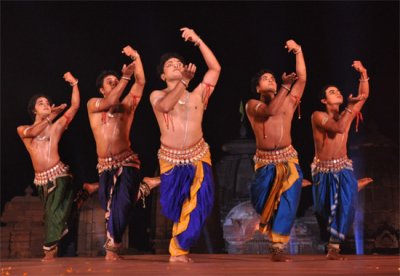 Rudrakshya 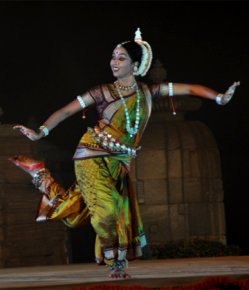 Madhusmita Mohanty On the final day, for Shiva Stuti, the music was composed by the legendary singer Pandit Raghunath Panigrahi, who accompanied the singers and set the mood. He has been keeping indifferent health, but his spirit is as cheerful as he used to display when young. In her solo, Madhusmita Mohanty, a disciple of gurus Bichitranand Swain, Gangadhar Pradhan and Aruna Mohanty, presented 'Bhumisuta' - Daughter of Earth - choreographed by Aruna Mohanty, which I happened to see Aruna perform during the 4th edition of International Odissi Festival in December 2011. I had enjoyed her approach enacting character of Sita, who had given test of her pious, spotless character through fire, 'agnipariksha.' On hearing rumours about her being a captive in Ashokavana and how Ravana made advances on her, but did not succeed, there were still unpleasant rumours among common people about her character, so Rama asked Lakshmana to send her away to the forest, even though she was pregnant. Shocked at the punishment accorded to her, Sita begged of her mother earth, Bhumi, to open up and take her back. Sita's agony moves audiences whenever such enactment is presented. Madhusmita succeeded in evoking that response. It is a 'khyata katha vastu,' well known episode, and its handling when done sensitively has great appeal. Madhusmita did Aruna proud playing the role with dignity. In a solo rendering it is natural to recall the episodes which reinforce Sita's state of mind on hearing such punishment. The impact of staging few key incidents of Ramayana is indelible. Earlier, Madhusmita had begun with Haragaurashtakam which evoked devotional mood. Both the numbers were captivating. The accompanying musicians enhanced the mood. However, the evening belonged to Devraj and Ellora Pattnaik, brother and sister duo from Canada, children of Odissi exponent Chitralekha Pattnaik. Trained by her, gurus Gangadhar Pradhan, Kelucharan Mohapatra and Sanjukta Panigrahi, the duo won over the discerning audience with their flawless and imaginative presentation. I had last seen them ten years ago in the 1st edition of International Odissi Festival in Washington DC, and was impressed by their talent and careful grooming under their mother and gurus. During last ten years, they have scaled artistic heights as was obvious from the word go when they appeared on stage. From selection of costumes, to entries and exits there was perfect coordination as was seen in music composed by Devraj. Pallavi in Kedar established at once their dancing, with Devraj's masculine movements and Ellora as a foil with her graceful movements. While dancing they clapped, kept the beat and performed with joy. It was obvious that there was a conscious attempt to highlight Odissi movements displaying the form at its best. 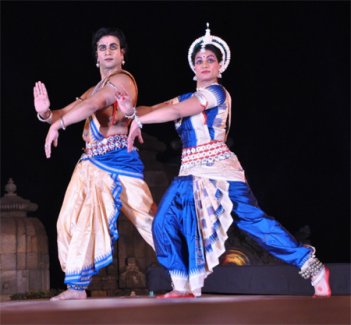
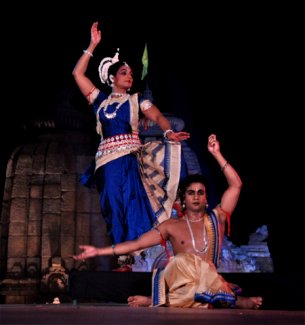
In the second choreographic work Harihara in praise of Lord Shiva and Vishnu, they excelled in delineating iconic presentations of the two deities with their vehicles, weapons they wield, ornaments they wear, enacting event like Ravana's attempt to lift mount Kailash and Lord Shiva, pressing with his toe, making Ravana understand the Lord's supreme power, Rama's crossing setu, the bridge, by just holding an arm horizontally, prayer by Gajendra to Vishnu when the crocodile tried to swallow him by his foot, and protecting Gajendra, Vishnu threw Sudarshan chakra, the disc at the crocodile. If Lord Shiva displayed virtuosity in playing damaru, so did Lord Vishnu playing mridanga, Shiva addressed as Gangadharau and Vishnu as Shikhandamauli, with peacock feather - ah, such were suggestive touches complementing the Sanskrit sahitya, embellishing the dance. Devraj with his all round command over music, composition, understanding of percussion and study of mardala, choreographic skills and flawless execution of movements with matching dancing by Ellora won critical appreciation of audiences. Living in distant Canada, as Indian Diaspora, doubtless they have maintained very high standards. Indeed, they deserve to be seen more often in not only Orissa but also all over India.
Jyoti Srivastav and her group under the banner of Vaishali Dance Academy based in Noida, UP, performed Kedar Kamodi pallavi emphasizing vigorous movements in Kedar and graceful in Kamodi ragas respectively. The male dancer Rahul with his commanding stage presence in the all female group drew attention with movements so characteristic of Durga Charan Ranbir's style. Since Jyoti has been collaborating with Ramli Ibrahim, there were certain sections which reminded one of Ramli's overall presentations. Guru Durga Charan Ranbir specially choreographed Abhinaya Ganga, extolling Ganga's supremacy among rivers. The Sanskrit sahitya in praise of Ganga with traditional touches of arati, performed with lamp, and the papanashini, removing evil and sins, etc., were with appropriate music interwoven cleverly. The flow of Ganga with arm movements, alignments diagonally covering the stage were captivating. What took away the charm of the presentation was too much of repetition and several climaxes. Just when one thought the presentation would end, it continued for a long time and generated a feeling of uneasiness. The choreography needs to be edited without losing visual appeal of its group compositions. The shlokas, prayers, epithets, similes, a tradition of Sanskrit poetry, helps only up to a point. But visually too much of it becomes cloying. Whereas Jyoti's and Rahul's dancing was commendable, the group would do better with more practice. The three day festival, in spite of unusual dipping of mercury, was attended by large crowds. The Dept of Tourism and the dynamic secretary Mr. Ashok Kumar Tripathy did not leave any stone unturned in its successful mounting, and also roping in DD Television to nationally telecast it every evening. In terms of publicity, hoardings all over Bhubaneswar and outreach, the festival provides a role model. What with god given setting of the breathtaking ambience of a group of temples as a backdrop, and dancers appearing one after another in imaginative lighting, creating exquisite visuals, one shall remember the festival for long. Not only that, one also looks forward to attending it next year.
 Dr. Sunil Kothari is dance historian, scholar, author and a renowned dance critic. He is Vice President of World Dance Alliance Asia Pacific India chapter, based in New Delhi. He is honored by the President of India with Padma Shri, Sangeet Natak Akademi award and Senior Critic Award from Dance Critics Association, NYC. He is a regular contributor to www.narthaki.com and is a contributing editor of Nartanam for the past 11 years. Post your comments Pl provide your name and email id along with your comment. All appropriate comments posted with name and email id in the blog will also be featured in the site. |